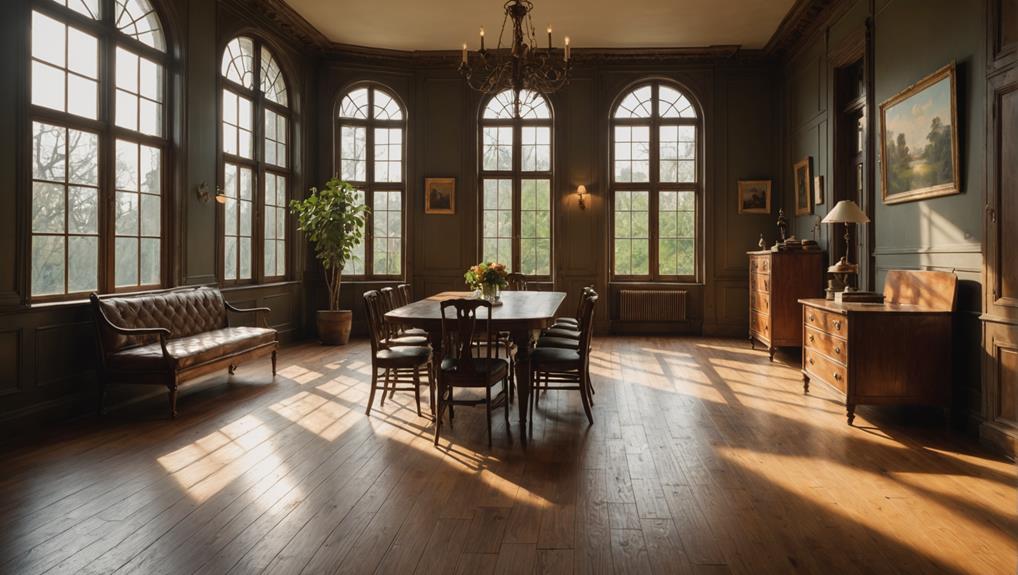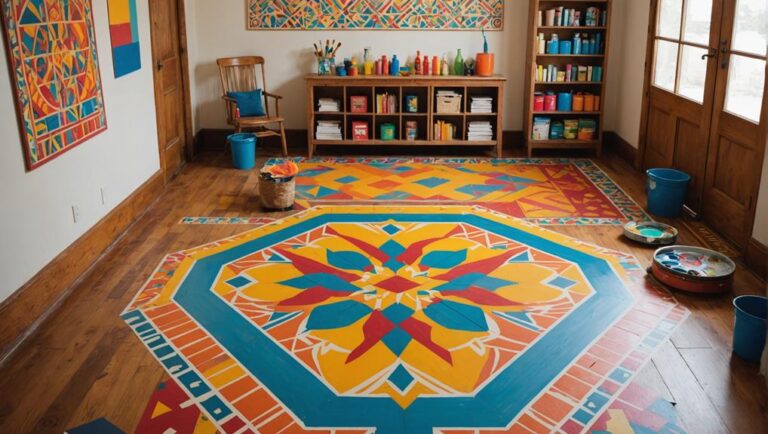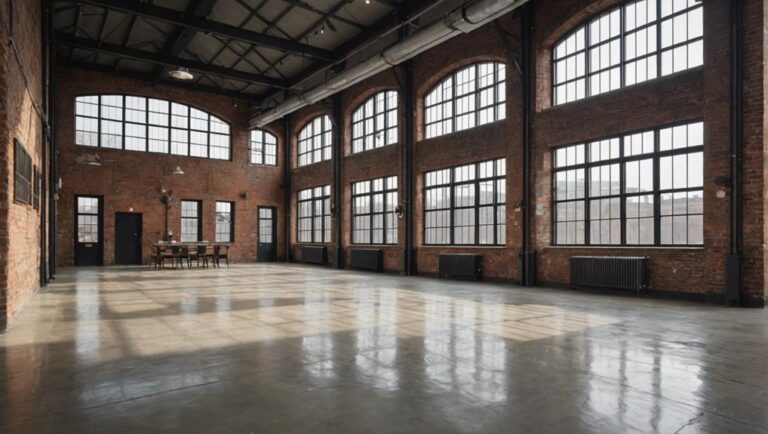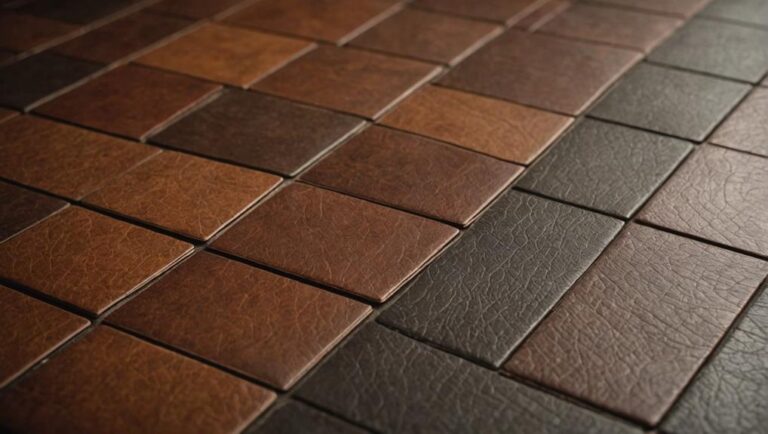To maintain authenticity in historic floor restoration, you must prioritize original materials and traditional techniques. Begin by understanding the flooring types specific to your building's era and culture. Sourcing authentic materials from specialized suppliers will guarantee historical accuracy. Carefully assess the floor's condition, documenting any damage while considering both craftsmanship and safety standards. Weigh traditional restoration methods against modern approaches to find a balance between preserving history and integrating necessary upgrades. Meticulous documentation of all processes further enhances authenticity, providing a valuable record for future generations. There's much more to uncover in your journey towards effective historic preservation.
Understanding Historic Flooring Types
When it comes to understanding historic flooring types, it is important to recognize the diversity in materials and styles that reflect the era and culture of their creation. Each flooring type not only serves a functional purpose but also embodies the aesthetic and practical considerations of its time. For instance, hardwood flooring, prevalent in colonial America, showcases durability and warmth, while its variations, such as oak or pine, exhibit distinct flooring material characteristics in grain and color.
In contrast, tile flooring, common in Mediterranean regions, reflects both artistry and practicality. The intricate designs often tell a story, providing insight into cultural influences and technological advancements of the period. Similarly, natural stone flooring, like slate or marble, speaks to the availability of resources and craftsmanship, emphasizing longevity and elegance.
Understanding these historic flooring styles is significant for anyone involved in restoration or preservation. Recognizing the unique characteristics of each material can guide you in choosing appropriate restoration techniques that align with safety standards. For instance, when dealing with aging hardwood, it is imperative to assess its structural integrity before proceeding with refinishing methods that could compromise its stability.
Moreover, the choice of materials impacts not only the aesthetic value but also the health and safety of the environment. Historic floors may contain materials that require careful handling, particularly when it comes to older installations that might harbor hazardous substances. By appreciating the myriad of historic flooring types and their characteristics, you can make informed decisions that honor the past while ensuring a safe, sustainable future.
Importance of Authentic Materials
Understanding the importance of authentic materials in historic floor restoration is vital for preserving the integrity of a building's historical narrative. When you engage in restoration, you're not just making aesthetic choices; you're guaranteeing that the materials resonate with the era and craftsmanship of the original structure. Using modern substitutes can dilute the building's story and potentially compromise its value, both historically and financially.
Authenticity is rooted in the use of materials that reflect the original construction methods and design principles. This means you need to prioritize historical resources that accurately represent the time period. Authentic materials not only enhance the visual appeal but also contribute to the building's structural integrity. For instance, original wood types or period-appropriate tiles can help maintain the building's functionality while honoring its past.
Material sourcing plays a significant role in this process. By working with suppliers who specialize in reclaimed or period-specific materials, you can guarantee that your choices align with the building's historical context. It's important to conduct thorough research to find reputable vendors who provide materials that meet safety standards. This diligence helps mitigate risks associated with inferior or inappropriate products, as well as guarantees compliance with preservation regulations.
Ultimately, by prioritizing authentic materials in your restoration efforts, you're safeguarding not just the physical structure, but also the cultural narrative that it embodies. This commitment to authenticity enriches the experience for future generations, allowing them to appreciate the building's true historical significance.
Researching Historical Context
Researching the historical context of a building is fundamental for any successful restoration project. Understanding the historical significance of your structure not only informs design choices but also guarantees that the final outcome respects its architectural styles. Each detail carries a narrative, and recognizing these stories can guide you in making informed decisions that maintain the building's integrity.
To deepen your understanding, consider creating a research table like this:
| Aspect | Details | Sources |
|---|---|---|
| Historical Period | Late Victorian (1880-1900) | Local archives, libraries |
| Architectural Style | Queen Anne | Architectural journals |
| Key Features | Asymmetrical façade, turrets | Heritage documentation |
| Material Usage | Original hardwood floors | Building permits |
| Restoration Techniques | Period-appropriate methods | Restoration manuals |
This table serves as a concise reference that highlights elements essential for maintaining authenticity. By analyzing architectural styles, you can identify specific design elements that are critical to the building's character. Each period has distinct features and materials that contribute to its historical significance.
As you explore your research, pay attention to how historical context informs current safety standards. Confirming that your restoration adheres to these standards while preserving the original character is fundamental. This balance not only honors the past but also guarantees a safe space for future generations.
Assessing Floor Condition
When evaluating the condition of historic floors, you'll want to employ multiple visual inspection techniques to identify surface wear, discoloration, and any signs of damage. It's equally essential to conduct tests for structural integrity, ensuring that the underlying support can withstand further restoration efforts. This thorough evaluation will not only inform your approach but also help maintain the floor's authenticity.
Visual Inspection Techniques
Conducting a thorough visual inspection is essential for accurately evaluating the condition of historic floors. You'll want to start by examining the surface for any signs of wear, such as scratches, discoloration, or imperfections that could indicate underlying issues. Pay close attention to joints and seams, as these areas often reveal vital information about the floor's integrity. It's also important to look for any signs of moisture damage, which can compromise both the aesthetic and structural aspects of the flooring.
During your inspection, keep preservation ethics in mind. You should document your findings meticulously, noting any repairs or alterations that may have been made in the past. This will not only help you understand the floor's history but also guide your decision-making for future restoration efforts.
Testing for Structural Integrity
A sturdy wooden beam may seem solid at first glance, but testing for structural integrity is essential in evaluating the overall condition of historic floors. You can't rely solely on visual inspections; conducting thorough structural assessments is vital for ensuring safety and longevity. Start by checking for signs of deterioration, such as rot, insect damage, or warping.
Next, employ integrity testing methods like load testing, where you apply weights to gauge the beam's strength and resilience. This process helps identify any hidden weaknesses that may not be visible externally. Additionally, consider using non-destructive testing techniques, such as ultrasound or moisture meters, to assess internal conditions without compromising the material.
It's also important to evaluate the connections between beams and their supports, as these joints often bear significant stress. Document all findings meticulously, as this data will guide your restoration decisions.
Techniques for Restoration
When you're considering techniques for restoring historic floors, it is crucial to weigh traditional restoration methods against modern preservation techniques. Each approach offers distinct advantages, with traditional methods often emphasizing craftsmanship and historical accuracy, while modern techniques may provide enhanced durability and efficiency. Understanding these options will help you maintain authenticity while ensuring the longevity of the restored floors.
Traditional Restoration Methods
Restoring historic floors demands a careful blend of traditional techniques that honor the craftsmanship of the past while guaranteeing the integrity of the materials. When you engage in restoration, it is crucial to utilize handcrafted techniques that replicate the methods used by artisans of the time. This approach helps preserve the floor's historical authenticity and enhances its longevity.
Start by evaluating the condition of the flooring. If repairs are necessary, consider using traditional joinery methods, such as tongue and groove or dowel connections, which maintain the structural integrity of the wood. Avoid modern adhesives that can compromise the wood's natural movement and breathability.
For finishing, opt for natural oils or waxes instead of synthetic sealants. These traditional materials not only highlight the beauty of the wood but also allow it to breathe, preventing moisture buildup and potential damage.
Throughout the process, prioritize safety. Verify that any dust generated is controlled and use appropriate personal protective equipment. By respecting historical craftsmanship and adhering to proven methods, you can restore your floors while preserving their unique story for future generations.
Modern Preservation Techniques
While traditional methods lay the foundation for authentic restoration, modern preservation techniques offer innovative solutions that enhance both the aesthetic and structural integrity of historic floors. One such technique is digital preservation, which allows for meticulous documentation of the floor's original condition. This guarantees that any restoration work aligns closely with the original design, safeguarding the floor's historical value.
Innovative materials, such as eco-friendly adhesives and breathable coatings, are now commonly used. These materials not only provide durability but also protect the integrity of the wood by allowing it to breathe, preventing moisture buildup that can lead to damage.
Here's a quick overview of these techniques:
| Technique | Key Benefits |
|---|---|
| Digital Preservation | Accurate documentation and analysis |
| Eco-friendly Adhesives | Reduces environmental impact |
| Breathable Coatings | Protects wood from moisture |
| Restoration Software | Enhances planning and efficiency |
Choosing the Right Craftsmen
Finding the right craftsmen for historic floor restoration is crucial to preserving the authenticity of your space. The craftsmen qualifications you seek should include extensive experience in restoring similar types of flooring, along with a deep understanding of the historical context of your building. This knowledge guarantees that the methods and materials used align with the original construction techniques, maintaining the character and integrity of your floors.
When evaluating potential craftsmen, consider their portfolio. Look for prior projects that mirror your needs, focusing on the level of detail and quality. This review not only showcases their skill but also provides insight into their ability to collaborate effectively on your project. Project collaboration is essential, as it involves open communication and a shared vision for the restoration. Ascertain that the craftsmen are willing to listen to your ideas while also providing professional guidance based on their expertise.
Additionally, don't hesitate to ask for references from previous clients. Speaking to those who have worked with the craftsmen will give you a clearer picture of their reliability, work ethic, and overall satisfaction with the completed projects. Safety is paramount in historic restorations, so verify that the craftsmen adhere to best practices and regulations, guaranteeing a secure and compliant work environment.
Preservation vs. Modernization
How do you strike the right balance between preserving the historical integrity of your floors and incorporating modern conveniences? It's a delicate dance that requires you to appreciate the historical significance while also reflecting on the practical needs of today's living. Achieving this design balance isn't just about aesthetics; it's about ensuring that your home remains functional and safe.
When opting for modernization, there are key factors to reflect on:
- Material Selection: Choose materials that mimic the original but offer enhanced durability and safety features.
- Technology Integration: Look into modern underfloor heating systems that can be installed discreetly, ensuring comfort without compromising the floor's appearance.
- Maintenance Practices: Use contemporary cleaning solutions that won't damage historical finishes but will keep your floors looking pristine.
Navigating these choices can be challenging. You might feel tempted to replace worn-out sections with modern alternatives, but it's essential to maintain continuity with the original design. This can often lead to a more cohesive look that honors the craftsmanship of the past while accommodating today's lifestyle.
Additionally, consulting with specialists in historic restoration can help you make informed decisions. They can guide you on techniques that respect the original character of your floors while allowing for modern updates. Aim for a thoughtful approach that honors the past while ensuring your space remains safe and livable.
Incorporating Sustainable Practices
When restoring historic floors, it's essential to take into account sustainable practices that align with your preservation goals. By selecting eco-friendly materials, employing energy-efficient techniques, and implementing waste reduction strategies, you can enhance both the integrity and sustainability of your project. This approach not only respects the past but also guarantees a minimal environmental footprint for future generations.
Eco-Friendly Materials Selection
A significant number of homeowners and restorers are increasingly prioritizing eco-friendly materials in historic floor restoration, recognizing the dual benefits of sustainability and authenticity. By choosing materials that adhere to sustainable sourcing practices, you can guarantee that your restoration efforts not only preserve the integrity of the structure but also positively impact the environment.
When selecting eco-friendly options, consider the following aspects:
- Reclaimed Wood: Using salvaged timber not only reduces waste but also adds character to your floors.
- Natural Finishes: Opt for finishes that are free from harmful chemicals, guaranteeing a safer indoor environment.
- Bamboo Flooring: As a rapidly renewable resource, bamboo provides a durable and stylish alternative to traditional hardwoods.
Energy-Efficient Restoration Techniques
What methods can you employ to enhance energy efficiency while restoring historic floors? First, consider insulation improvements. By installing high-quality insulation beneath the flooring, you can greatly reduce heat loss, making your space more energy-efficient. Materials such as cellulose or sheep's wool can maintain the building's historical integrity while providing effective thermal resistance.
Next, don't overlook the potential of solar panel integration. If your historic building allows, installing discreet solar panels on the roof can harness renewable energy, reducing reliance on fossil fuels. This approach not only benefits the environment but can also lead to long-term savings on energy bills.
When restoring floors, verify that any enhancements you make are reversible and minimally invasive to preserve authenticity. For example, using breathable materials in your insulation can help prevent moisture issues that might compromise the structure.
Waste Reduction Strategies
Enhancing energy efficiency naturally leads to reflections around waste reduction during historic floor restoration. By focusing on waste reduction strategies, you can both preserve the integrity of the space and promote sustainability. It's crucial to implement practices that prioritize recycling materials and minimizing waste to create a safer and more eco-friendly restoration process.
Consider these strategies:
- Assess existing materials: Before any work begins, evaluate what can be reused or repaired. This approach not only minimizes waste but also maintains the historical authenticity of the floors.
- Opt for sustainable suppliers: When purchasing new materials, select vendors who prioritize recycled or sustainably sourced products. This choice supports the environment and often offers better quality.
- Proper disposal methods: If materials must be discarded, confirm they're sent to recycling facilities instead of landfills. This step greatly reduces your project's ecological footprint.
Documenting the Restoration Process
In the intricate journey of historic floor restoration, documenting each step of the process is crucial for preserving the authenticity and integrity of the project. This restoration documentation not only serves as a historical record but also provides essential information for future maintenance and potential restorations. By maintaining detailed notes and photographic records, you create a thorough narrative of the restoration that can guide future efforts and guarantee that the original character of the floor is respected.
As you progress through the restoration, consider using a structured approach to documentation. Start by recording the existing conditions of the floor, noting any significant features, damages, or previous repairs. This baseline information is fundamental. As you undertake each phase of the restoration, take high-quality photographs to capture the transformation visually. These photographic records should include wide-angle shots of the entire surface as well as close-ups of intricate details and repairs.
Additionally, keep a log of materials used and techniques applied during the restoration process. This information not only informs future restorations but also guarantees that the materials are in line with historical accuracy. In cases where original materials are replaced, document the reasons for these decisions, emphasizing safety and compliance with preservation standards.
Thorough documentation guarantees that every choice made during the restoration process is transparent and can be revisited in the future. By prioritizing this aspect, you contribute to a more profound respect for the historical significance of the floor, securing its legacy for generations to come.
Educating Homeowners and Community
Educating homeowners and the community about historic floor restoration is essential for fostering an appreciation of preservation efforts. By enhancing awareness of local history and the craftsmanship skills involved, you can promote a culture of preservation that values the historical significance of your surroundings. Engaging in community workshops and homeowner education not only equips you with restoration resources but also encourages community involvement in maintaining these cherished spaces.
Consider the following aspects to deepen your understanding and involvement:
- Material Sourcing: Learn about sourcing authentic materials that meet preservation standards, ensuring your restoration aligns with historical integrity.
- DIY Restoration: Explore safe DIY restoration techniques that respect original craftsmanship while enhancing your personal skills and knowledge.
- Community Workshops: Participate in workshops to share ideas, gain insights, and connect with others who appreciate the value of historic preservation.
Frequently Asked Questions
How Can I Identify Original Flooring Materials in My Home?
So, you think you can just waltz in and identify original flooring materials, huh? Well, you're in for a treat! Start by examining any exposed edges; they might reveal layers of history. Look for unique grain patterns and colors that hint at the original material. Don't forget to check for signs of wear and tear, which can also guide you. Just remember, don't rush—ensure your safety while you're uncovering those hidden treasures!
What Are the Risks of Using Modern Materials in Restorations?
Using modern materials in restorations can jeopardize both structural integrity and aesthetic value. You might find that modern material compatibility with historical elements is often lacking, leading to potential damage over time. Preservation techniques rooted in traditional methods are vital for maintaining authenticity. Additionally, modern adhesives and finishes can emit harmful chemicals, posing safety risks. It's important to weigh these factors carefully to guarantee your restoration protects both your home's history and your health.
Can I Restore Floors Myself or Should I Hire Professionals?
You can certainly consider DIY restoration for your floors, but weigh the cost considerations carefully. If you're experienced and have the right tools, it might save you money. However, think about the risks involved—mistakes can lead to costly repairs. Hiring professionals guarantees expertise, safety, and often better results, especially in tricky areas. Ultimately, balancing your skills and budget with the project's demands is essential for a successful outcome.
How Do I Find Reputable Craftsmen for Historic Restoration?
Finding reputable craftsmen for historic restoration feels like searching for hidden gems in a sea of options. Start by examining their craftsman credentials; check for certifications and past projects. Look for reviews that highlight their mastery of restoration techniques. Don't hesitate to ask for references, ensuring their work aligns with your safety standards. Ultimately, a well-chosen craftsman will not only respect the history of your space but also enhance its beauty with skillful restoration.
What Are Common Mistakes to Avoid in Historic Floor Restoration?
When tackling historic flooring restoration, it's essential to avoid common mistakes. Don't rush the assessment process; take time to understand the original materials and restoration techniques that are appropriate for your specific floor. Skipping proper cleaning can lead to irreversible damage, so always prioritize safety and preservation. Also, be wary of using modern finishes that may not be compatible with historic materials, as they can alter the floor's integrity and appearance.




